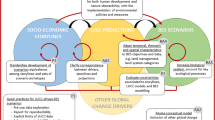Abstract
As discussed in the Introduction, both the UNCCD and the GEF use land cover to monitor land degradation. The UNCCD progress indicators (formerly known as impact indicators) should show progress made in achieving long-term benefits for people living in areas affected by desertification, land degradation, and drought, for affected ecosystems, and for the global environment. At its eleventh session, the COP adopted a refined set of six progress indicators (Decision 22/COP.11; see Annex 6) which will be used for the first time during the second leg of the fifth reporting process in 2016. Recommendations were made to the latest Conference of the Parties of the UNCCD (ICCD/COP(11)/CST/2) for refinements to the provisionally adopted set of impact indicators (Annex 6).
Access provided by Autonomous University of Puebla. Download chapter PDF
Similar content being viewed by others
11.1 In the Convention National Reporting
As discussed in the Introduction, both the UNCCD and the GEF use land cover to monitor land degradation. The UNCCD progress indicators (formerly known as impact indicators) should show progress made in achieving long-term benefits for people living in areas affected by desertification, land degradation, and drought, for affected ecosystems, and for the global environment. At its eleventh session, the COP adopted a refined set of six progress indicators (Decision 22/COP.11; see Annex 6) which will be used for the first time during the second leg of the fifth reporting process in 2016. Recommendations were made to the latest Conference of the Parties of the UNCCD (ICCD/COP(11)/CST/2) for refinements to the provisionally adopted set of impact indicators (Annex 6).
The findings of this report have implications for all three strategic objectives (SOs) of the UNCCD: SO-1 to improve the living conditions of affected populations, SO-2 to improve the conditions of affected ecosystems, and SO-3 to generate global benefits through effective implementation of the UNCCD (Table 11.1). Monitoring of drought using NDVI and NDWI could have implications for trends in access to safe drinking water (SO-1). It has been clearly shown that NDVI is a reliable measure of photosynthetic capacity and thus for monitoring trends in land cover and productivity of the land (SO-2). NDVI can also support reporting on global benefits related to trends in carbon stocks and biodiversity (SO-3), as shown in other sections of this report (also see Annex 2). Ideally, reporting on these indicators should be harmonized with reporting to the UNFCCC on carbon stocks and to the CBD on biodiversity indicators.
11.2 In a Revised GEF Resource Allocation Methodology
Land cover is used as an indicator for all three GEF focal areas affected by the System for Transparent Allocation of Resources (STAR) that calculates country-specific allocations from each focal areaFootnote 1:
Land Degradation—the latest Global Benefit Index (GBI) for the land degradation (LD) focal area was designed to take into account three key factors in accordance with GEF mandate for financing: (1) the need to control and prevent land degradation in land-based production systems; (2) the challenge of combating desertification in the drylands, including the need for adaptation to drought risks; and (3) the need to address livelihoods of vulnerable populations. Proxy indicators were derived for each of these factors based on available data.
With regard to factor (1), a quantitative estimate of land area (in km2 or as percent of territory) affected by LD was used as a proxy indicator for loss of ecosystem function and productivity. The indicator was derived by Bai et al. (2008) using NDVI. Each country’s share of the global total area affected was calculated for use in the GBI. The three indices were assigned weights as follows: 60 % to dryland area, 20 % to rural population, and 20 % to land area affected.
GBILD = (0.2 × global share of land area affected) + (0.6 × proportion of dryland area) + (0.2 × proportion of rural population)
Climate Change: For its land-use, land-use change, and forestry (LULUCF) component, it uses forest cover in hectares and absolute change in forest cover, as reported by countries to FAO. NDVI could potentially be used to strengthen this index as NDVI is strongly correlated with vegetation dynamics in humid areas.
Biodiversity: This index uses distribution of terrestrial eco-regions, including threatened eco-regions as monitored by WWF. Also here, the use of NDVI could improve data quality if it is used consistently.
Trends in NDVI could thus become an important part of a land-cover indicator cutting across three GEF focal areas and used as a proxy for productivity, carbon stocks, and biodiversity. With regard to the land degradation focal area, a revised GEF STAR should be based on all the six core indicators identified for the UNCCD Strategic Objectives (see Table 11.1 and Annex 6). However, with a more robust application of NDVI based on recent advances, this index might be given a greater weight in a revised STAR, as it can contribute to monitoring of five of the UNCCD indicators if applied consistently and using the most reliable datasets.
Notes
- 1.
GEF/POLICY: PL/RA/01, March 14 2013: System for Transparent Allocation of Resources (STAR).
Reference
Bai ZG, Dent DL, Olsson L, Schaepman ME (2008) Proxy global assessment of land degradation. Soil Use Manag 24(3):223–234
Author information
Authors and Affiliations
Rights and permissions
Copyright information
© 2015 The Author(s)
About this chapter
Cite this chapter
Yengoh, G.T., Dent, D., Olsson, L., Tengberg, A.E., Tucker, C.J. (2015). Recommendations for Future Application of NDVI. In: Use of the Normalized Difference Vegetation Index (NDVI) to Assess Land Degradation at Multiple Scales. SpringerBriefs in Environmental Science. Springer, Cham. https://doi.org/10.1007/978-3-319-24112-8_11
Download citation
DOI: https://doi.org/10.1007/978-3-319-24112-8_11
Published:
Publisher Name: Springer, Cham
Print ISBN: 978-3-319-24110-4
Online ISBN: 978-3-319-24112-8
eBook Packages: Earth and Environmental ScienceEarth and Environmental Science (R0)




